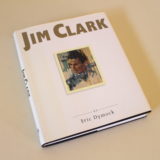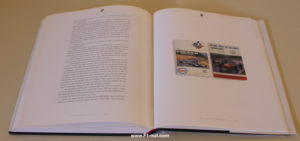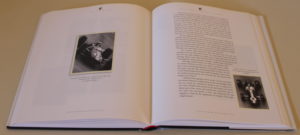
Book Review: Jim Clark by Eric Dymock


:
Positives
Negatives
It’s been 50 years since the passing of 2 time world champion Jim Clark in a F2 race at the Hockenheimring. It’s hard for modern F1 fans to appreciate the silken skills of F1 champions from the 60s – although compare current F1 technology to an era with manual gear shifts, no power steering, limited driver safety aids and no engineer to driver radio, it’s easier to conclude that a driver’s skill and bravery was definitely more on display. One of the best Jim Clark books is journalist Eric Dymock’s “Jim Clark” published back in 1997.
Physically, this book is a very presentable hardcover title befitting of a F1 world champion biography from the layouts used and its selection of archival photos and memorabilia.
Every 2nd page includes a photo, often a thumbnail image of a personal photo, an official race poster or program, a GP winners trophy, official portraits and famous Michael Turner art. The photography reproduction is excellent – no grainy B&W or unnecessarily enlarged photos – there really is a great selection of photos covering Clark’s career and the 60’s era GP racers.
At 250+ pages, Dymock has split the book into 17 odd chapters including a foreword by Sir Alex Trotman (then CEO of Ford Motor). The early chapters and the epilogue are very much a reflection of Jim Clark’s legacy, his nail-biting edginess and Dymock doesn’t skirt around the issues of his poor commercial negotiations, and post-death baggage of his tax affairs.
Dymock delves into Clark’s upbringing in his Scottish farming family driving Ford tractors to his first introduction to motor racing via rally racing in the Sunbeam saloon car. The chapters progress from amateur racing in the DK4, Ecosse D Type to meeting Colin Chapman and single seater racing with the Lotus team.
The rest of the chapters cover his Chapman/Lotus career bring 2 world championships and success at Indianapolis. In his book, Dymock examines Jim Clark’s in-car talent and race career but also his out-of-car challenges of dealing with deaths of his fellow drivers, divided loyalty to the family farm, money issues and his female companions.
This book is a good read but the real interest is the opportunity to closely study the previously never seen private photos and historical memorabilia.
A new edition of this book was released in 2017 which I haven’t had a chance to read or view but I believe many new colour photos are included.
Wow factor/money shot: Lots of private photos; Chapter on Indianapolis
Suitable for: Jim Clark and F1 history fans






















